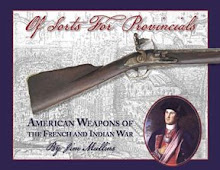"Figure of the Mariner's Compass"
One of the pieces of gear that shows up with some frequency in the Virginia back country is the pocket compass (even fairly frequently with those who aren't surveyors). From what I can gather, two basic types were used in the 18th century (and thanks to Steve R and others for their help with some of these quotes!).
The first variety is of brass:
http://books.google.com/books?id=MVA05byHmKoC&lpg=PP1&ots=-LG8WGcU5x&dq=excavating%20sutler's%20house%20starbuck&pg=PA39#v=onepage&q=compass&f=false
http://www.whatsitworthtoyou.com/index.cfm?fuseaction=appraisal.certificate&item_ID=213419
Pocket compass and sundial (1978.77.3) used by Gabriel du Brutz at the surrender of Cornwallis at Yorktown, Virginia, October 19, 1781. In the collection at the NC Museum of History, Raleigh, North Carolina.
and the second featured a wooden case. Examples from the period can be seen here:
Lewis and Clark Expedition cased pocket compass ca. 1804 Smithsonian NMAH
http://www.armygeographer.org/instruments-a-equipment
sometimes surveyor George Washington 1770:
http://rs6.loc.gov/cgi-bin/query/P?mgw:1:./temp/~ammem_IIIK::
"In coming from our last encampment up the Kenawa, I endeavored to take the courses and distances of the river by a pocket compass, and by guessing.”
The Journal of William Calk, Kentucky Pioneer
Lewis H. Kilpatrick
The Mississippi Valley Historical Review, Vol. 7, No. 4. (Mar., 1921), pp. 363-377
Satrd 25 "....Eanock ABram & I got lost tuesday night & it asnowing & Should a lain in the mountains had not I had a pocket Compas By which I Got in a littel in the night and fired guns and they heard them and caim in By the Repoart..."
Virginia Gazette
(Purdie), Williamsburg ,
June 30, 1775. Supplement
FINCASTLE, May 21, 1775. RUN away from the subscriber, living on Neck creek, near Mr.Thopson's mill, an Irish servant man named THOMAS
BENSON, about 5 feet 9 inches high, wears his own long black hair tied, and has lost the half of his left hand little finger; had on a home made flax linen shirt, a
pair of tow linen trousers, and carried with him a blue home made cloth coat, a red and yellow silk and cotton waistcoat, buckskin breeches, a rackoon hat, a brass
mounted long smooth-bore gun, marked on the side-plate MM 1769, and on the barrel W. MORGAN, a shot-bag and powder-horn, a canister with 2 lbs. of powder, a falling axe, a pocket compass, &c. &c. He likewise stole his indentures, and, being a very good scholar, it is probable he may make an assignment on them. He is supposed to be with Samuel Ingram's servant man, as they both went off about the same time. Whoever secures the said servant, so that I get him again, shall have 5 l. reward, and, if out of the county, reasonable charges, paid by NATHANIEL MORGAN.
http://books.google.com/books?id=tPwTAAAAYAAJ&pg=PA279&dq=pouch+and+horn&hl=en&ei=7s9aTPGQJYOC8ga5trX0AQ&sa=X&oi=book_result&ct=result&resnum=2&ved=0CDcQ6AEwAQ#v=onepage&q=pouch%20and%20horn&f=false
A List of Effects Lost of Sundry Soldiers of Captain William Formans Company of Hampshire County Volunteers appraised by Lieutenant Anthony Miller & Ensign David Wilson officers of s<^ : Company Being duely Qualify*^ for that Purpose
1 Captain William Forman a Rifle Gun . . in" s"
Shotpoutch & horn 10/ pocket Compas 5/ . . 00" 15"
Westward Into Kentucky: The Narrative of Daniel Trabue
http://books.google.com/books?id=YSz82Es5IXgC&printsec=frontcover&dq=Westward+Into+Kentucky:+The+Narrative+of+Daniel+Trabue&hl=en&ei=d825Tc_9LvPr0QHc86ioCA&sa=X&oi=book_result&ct=result&resnum=1&ved=0CCoQ6AEwAA#v=onepage&q=compas&f=false
"He got to beleave he could make his escape. He communicated this to some of the prisoners and 7 of them agred to embark in the Venture. he told these 7 Men to make ready, that the first Dark rainey night they would start, and try if posible to procure a Gunsa nd ammunition, etc. They generally Drawed several Days' provision at a time and they saved and laid by such as they thought would Do for their Jurney...he looked at some of their very best superfine broad Cloath....He also took up 2 fine lineng shirts, breeches, and stockings, and Cravets, also trimmings. Had them all tyed up in a large handkercheif and took them to his logging....They had flints and spunk...When Morning came they then started, one man to steer the way and where ever he put his foot they all was to go in teh same track. The man that was behind had a turkey's foor and a Deer's foot. If the least sighn was made this hindmost man was to either make a Deer's track of turkey's track...They knew they would be followed and they must be very carefull so that they could not be tracked...James Trabue went a head. He had a pockit compas.
1785:
http://books.google.com/books?id=6yADAAAAMAAJ&lpg=PA45&ots=7epqD-mKX6&dq=We%20turned%20off%20from%20the%20river%3B%20we%20all%20had%20pocket%20compasses%20to%20steer%20by&pg=PA45#v=onepage&q=We%20turned%20off%20from%20the%20river;%20we%20all%20had%20pocket%20compasses%20to%20steer%20by&f=false
“The third day, myself and six more separated from the rest of the company, in order to kill something to eat, and try if we could not find a better and nearer way home. We turned off from the river; we all had pocket compasses to steer by..."
As for reproductions, brass ones of varying quality abound, and the Ames instrument company has offered wooden cased ones:
http://www.amesinstrumentcompany.com/
So now you can get yourself lost, and found in a period fashion!













